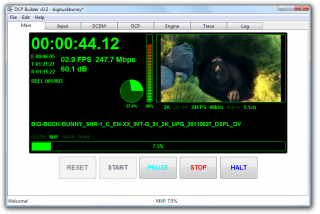Courses
Evaluation of the workshop on Creating DCPs with free software
On February 20 we attended the course on DCP creation with free software Open DCP and DCP Builder by 709 Media Room, given by Fernando Alfonsín, an editing and postproduction professional with more than 15 years of experience in the audiovisual sector and with a very high technical knowledge of the processes of creating digital copies for the distribution of content in theaters.
The course was divided into two main parts: a theoretical part and a practical part. After a brief presentation and theoretical introduction to the concept of DCP (Digital Cinema Package), Fernando explained the DCI standard for the creation of DCP’s in its different variables and formats.
We were able to learn about the different types of FADs that currently exist and the particularities of each one. Throughout the explanation, Fernando Alfonsín not only provided his great theoretical knowledge, but also added practical advice for each phase of the creation of a FAD.
We went through all the key steps to take into account in the creation of the DCP such as: the DCI standard, list of materials needed to obtain a DSDM, the XYZ color space, or the basic structure of files that make up a DCP. Understanding each part of the process and knowing what implications it has on the final result of the project was one of the great contributions of the course.
Throughout this first part, Fernando managed not only to explain clearly and concisely the steps to follow but also helped us to understand each of the elements and files that make up a DCP in order to have control of the process at all times.
At this point, Fernando demonstrated his great theoretical and practical mastery of the whole process with the answers to questions from a group that was quite homogeneous in knowledge and with an eagerness and great interest in learning and absorbing as much information as possible from the professor.
Although the main subject of the course was the creation of a DCP with free software, Fernando did not miss the opportunity to explain basic notions of stereoscopy, since with the advances in digital projection and the increasing boom of new content shot in 3D it is necessary to have knowledge of this workflow. In this way, we gave a theoretical review of the different forms of 3D projection and we could see what are the problems that we can find when generating a stereoscopic DCP and its possible solutions.
Another fundamental aspect of the course was the integration of subtitles within DCP and the limitations that exist with current free software. There was a great interest in this point since one of the great advantages of DCP is to be able to include within the same playlist several subtitle files in different languages, without the need to make different copies. We learned how to understand and manually modify the ASSETMAP and CPL files in relation to the customization of the playlist with several subtitles and the essential characteristics of the subtitles such as font, color, etc.
Finally, Fernando talked about the possibility of encrypting the DCP and generating a key to open it called KDM. We were able to reflect on the anti-piracy implications of this and the advantages it offers such as the possibility of being limited by date preventing the reproduction of the DCP outside the limits established in the KDM. But there are also real limitations as the KDM file is specific to each type of projector on which it will be played which can cause problems when distributing our digital copy. The big difference between free software and paid software for DCP creation is that it is not possible to generate the KDM file to encrypt the copy.
In the afternoon we had a practical session where we were able to make a DCP copy of a 2D trailer and another copy of the same trailer in 3D.
It was very interesting and instructive to be able to apply in a practical way everything we had learned in the morning at a theoretical level. We used the two software that are currently available for free to create DCP’s. We were able to see how with Open DCP the process has to be done in parts while DCP Builder is presented in parts. We could see how with Open DCP the process has to be done in parts while DCP Builder is presented as a more complete solution being able to generate DSDM and DCP at the same time.
Subtitling also took up a large part of the hands-on session. We generated files manually with a free subtitling software that could be easily and comfortably embedded in our DCP generated with DCP Builder.
All attendees were very satisfied with the development of the course, which had a perfect balance between theoretical and practical content, but above all with the great ability of the teacher, Fernando Alfonsín, to explain and answer all the questions asked.
Attendance at the course was very good as all available places were filled and it is worth noting that there were attendees not only from Madrid but also from different regions of Spain, such as the Basque Country and Pamplona.
Due to the great reception and demand of this course, 709 Media Room organizes for the end of next April the same workshop on DCP Creation with Free Software taught again by Fernando Alfonsín.



